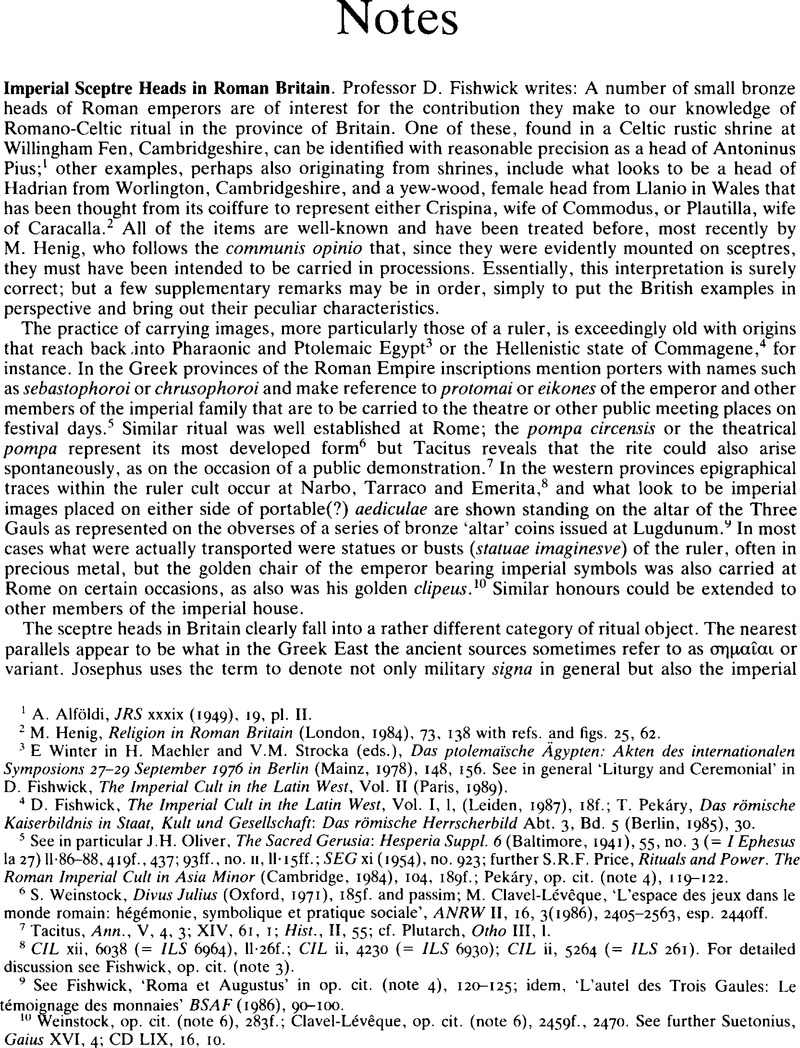Published online by Cambridge University Press: 09 November 2011

1 Alföldi, A., JRS xxxix (1949), 19, pl. II.Google Scholar
2 Henig, M., Religion in Roman Britain (London, 1984), 73, 138 with refs. and figs. 25, 62.Google Scholar
3 Winter, E in Maehler, H. and Strocka, V.M. (eds.), Das ptolemaïsche Ägypten: Akten des internationalen Symposions 27–29 September 1976 in Berlin (Mainz, 1978), 148, 156.Google Scholar See in general ‘Liturgy and Ceremonial’ in Fishwick, D., The Imperial Cult in the Latin West, Vol. II (Paris, 1989).Google Scholar
4 Fishwick, D., The Imperial Cult in the Latin West, Vol. I, 1, (Leiden, 1987), 18f.Google Scholar ; Pekáry, T., Das römische Kaiserbildnis in Staat, Kult und Gesellschaft: Das römische Herrscherbild Abt. 3, Bd. 5 (Berlin, 1985), 30.Google Scholar
5 See in particular Oliver, J.H., The Sacred Gerusia: Hesperia Suppl. 6 (Baltimore, 1941), 55Google Scholar , no. 3 (= I Ephesus la 27) 11–86–88,419f., 437; 93ff., no. n, 11. 15ff.; SEC xi (1954), no. 923 ; further Price, S.R.F., Rituals and Power. The Roman Imperial Cult in Asia Minor (Cambridge, 1984), 104, 189f.Google Scholar ; Pekáry, op. cit. (note 4), 119–122.
6 Weinstock, S., Divus Julius (Oxford, 1971), 185f. and passimGoogle Scholar ; Clavel-Lévêque, M., ‘L'espace des jeux dans le monde romain: hégémonie, symbolique et pratique sociale’, ANRW II, 16, 3(1986), 2405–2563, esp. 2440ff.Google Scholar
7 Tacitus, Ann., V, 4, 3; XIV, 61, I; Hist., II, 55; cf. PlutArch. Otho III, 1.
8 CIL xii, 6038 (= ILS 6964), II·26f.; CIL ii, 4230 (= ILS 6930); CIL ii, 5264 (= ILS 261). For detailed discussion see Fishwick, op. cit. (note 3).
9 See Fishwick, ‘Roma et Augustus’ in op. cit. (note 4), 120–125; idem, ‘L'autel des Trois Gaules: Le témoignage des monnaies’ BSAF (1986), 90–100.
10 Weinstock, op. cit. (note 6), 283f.; Clavel-Lévêque, op. cit. (note 6), 2459f, 2470. See further Suetonius, Gaius XVI, 4; CD LIX, 16, 10.
11 Pieket, H.W., Talanta ii (1970), 55–88Google Scholar , esp. 66ff., citing Josephus, Ant. lud., XVIII, 55; Bell, lud, II, 169, also Lucian, De Dea Syria, XXXIII, describing a sacred standard called σημήιον.
12 Mnemosyne xxiii (1970), 192–195 ad SEG vi, 731.
13 Vetters, H., MDAI(I) xxv (1975), 393–397.Google Scholar
14 Ritterling, E, BJ cxxv (1919), 9–37, esp. 31f.Google Scholar : Behrens, G., MS xxxvi (1941), 8ff., esp. 21Google Scholar ; cf. Alföldi, A., AJA lxiii (1959), 1–27CrossRefGoogle Scholar , esp. 27, figs. 40f. (pl.10).
15 Price, op. cit., (note 5), 102, n.4, 110 with references.
16 I Ephesus la 27, op. cit. (note 5). For the image of the senate see Kienast, D., Chiron xv (1985), 253–283, esp. 269.Google Scholar
17 Pekáry, op. cit. (note 4), 55–65; Fishwick op. cit. (note 3).
18 Curtius, L., MDAI(R) lv (1940), 36–64Google Scholar ; Etienne, R., Le Culte impérial dans la Péninsule ibérique d'Auguste à Dioctétien: BEFAR cxci (Paris, 1958), 390, 400Google Scholar ; Bosch Gimpera, P., ‘Katalonien in der Kaiserzeit’, ANRW II, 3 (1975), 572–600, esp. 580f.Google Scholar
19 For Tiberius' prohibition of the practice see Suetonius, Tib., XXVI, 1. Domitian, unlike Hadrian, had no inhibitions on this score: Pliny, Paneg., LII, 3.
20 P. Oxy. XII, 1449,11. 1 If. Nock, A.D., HSCP xli (1930), 1–62Google Scholar , esp. 3, 29, 56 (= Nock, A.D. [ed. Stewart, Z.], Essays on Religion and the Ancient World [Oxford, 1972]Google Scholar , I, 204, 224, 246) seems to take such offerings to be necessarily votives.